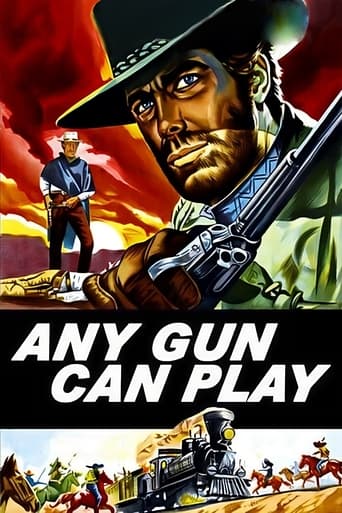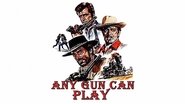JohnWelles
"Any Gun Can Play" (1967), directed by Enzo G. Castellari, is a very good pastiche of Spaghetti Westerns, especially Leone's. The first half is great, which, apart from the opening which is a direct nod to "For a Few Dollars More", with Monco, Colonel Douglas Mortimer and El Indio lookalikes walking into a ghost-town and then promptly killed by a Bounty Hunter called "The Stranger", is entirely serious, with great gunfights (especially the train-robbing scene), fast and furious action and nice performances from Gilbert Roland, George Hilton and (who manages well, considering that he is badly miscast) Edd Byrnes. But then, when the film reaches the half-way mark, there is a jokey fist-fight between Hilton and Byrnes. It isn't very funny, and is the weakest part of the film, but it throws everything you have seen previously in a new light. You realise that in fact the whole thing is a spoof of Spaghetti Western conventions, and in retrospect, the first half is so well done that you completely miss this spoof undercurrent. What now follows is a more obvious parody, with even some acrobatic jumping around from Brynes that predates all those seventies Circus Westerns. The ending, a complete send-up of "The Good, the Bad and the Ugly" climax, is very well done, as in other hands it could have been very silly. So, a pretty fun Spaghetti Western, that doesn't take itself too seriously. I would recommend it to anyone who likes Spaghetti Westerns.
lost-in-limbo
A train holding union soldiers is transporting $300,000 of gold, along with a banker Clayton, who's there to see it reaches its destination, but it's suddenly robbed by the bandit Monetero. However Bahunda nicks off with the gold and hides it, but when Monetero tries to get it out of him, he's killed by soldiers. The only clue is that of a medallion, but Monetero is captured and soon would be executed. A stranger dressed up as a priest comes by (who after the bounty of Monetero) and offers to save his life for half of the gold. In exchange Monetero gives him half of the medallion, but Clayton notices it and discovers something is up. Soon all three are crossing each other for the gold, but also the bank's insurance company and Monetero's gang are watching on, waiting for their chance to pounce.Just watching the opening sequence you'll know you're in for a spaghetti western with a tongue-in-cheek style and a reliance of sprinkling many references (some nicely realised) from other films (largely the Dollar trilogy) of its sub-genre. Director Enzo Castellari's sprightly direction is sprawling and mostly lightweight, but there's potential in many of his grand, showy set pieces and smooth rhythmic pace. Largely there's a lot of tussles, fist-fights (and plenty of acrobatic stunts) taking place, compared with all-out vicious shootouts. However most of these stunts are very well done, and very enjoyable and when the guns are blazing there's energy to burn. The traditional story sticks close to conventional details, but since there's a lot of conniving and outfoxing going on, the spontaneous nature makes sure you're never quite certain how it's eventually going to play out between the three. This leads up to many effective suspenseful moments, clever twists, and plenty of wink, wink. The humour within the starch script is pretty sly. Worked in favourably amongst the light and zesty style, is Giovanni Bergamini's dynamically taut framing and Francesco De Masi's impulsively rousing music score. The performances are extremely well tailored and form a striking rapport. George Hilton's wry and scuffed turn is solid as the ambiguous stranger. Gilbert Roland brings class and intelligence to his formidable Mexican bandit Monetero. Edd Byrnes gives a poised performance as Clayton, that holds up well. Kareen O'Hara doesn't get much to do, but is a worthy looker. Gerard Herter, Pedro Sanchez and Ivano Staccioli provide able support.A fun and worthy spaghetti parody/homage that throws one curve-ball after another and many fruitful down 'n' dirty antics.
Poseidon-3
The sensational success of Sergio Leone's spaghetti western trilogy (the "Man with No Name" films) created a tidal wave of imitators and spoofs that washed over the cinematic landscape. This one, a serious yet whimsical take on the genre, is one of the more enjoyable ones. Hilton plays a bounty hunter who heads out after Roland, a noted criminal who has just robbed a train of $300,000 in gold. Byrnes is a bank officer who was escorting the gold and who now wants to recover it. These three men compete with each other and sometimes align with each other in order to reach the treasure which has been buried somewhere and can only be found by using a medallion carrying a family crest on it. The medallion has been cut in two, meaning that the pieces must be reunited in order for the gold to be located. Lots of fighting and back-stabbing takes place on the road to the finale. Byrnes, though top-billed, is actually playing a more supportive role here. His famous hair looks quite ridiculous in the old west setting and he's no great actor, but he manages to drum up a few effective moments, notably when he decides to take on Hilton in a fistfight. Hilton is incredibly handsome and sexy. Again, he's not an actor that's going to raise the roof, but he does very well in his cocky and mysterious role. Roland adds presence and weight to the film and is effectively sly and dangerous. The film deliberately pays homage to other, greater spaghetti westerns in a tongue-in-cheek way. There are plenty of creative camera angles, intense stare-downs and elaborate fight sequences that go on too long on purpose. The facial blows are given a cracking whip sort of sound effect, enhancing the camp factor. The music for the film is enjoyable, too, and there's a hilarious Frankie Laine-esquire song over the credits referring to "The Stranger" (Hilton's character.) Careddu, sporting impossibly red hair, appears as Roland's cohort and lover. It's not a film to be taken seriously, but rather a gentle parody of the type of western that was being churned out at the time in droves. On that level, it succeeds rather nicely!
bensonmum2
A group of bandits rob a train of the gold shipment it is carrying. In their escape, the bandits split up. The one thief who knows where the gold is hidden is killed before he is able to talk. Three men have a different part of the "clue" that will lead to the gold. Can the banker, the bandit, and the bounty hunter work together to locate the missing loot? Or, will they kill each other first? - The plot is an obvious take-off of Leone's The Good, the Bad, and the Ugly. Various scenes in the movie are also lifted from other films by Leone, Corbucci, and more. But, to me, it's done in a way that doesn't show disrespect to the original work. Instead, Any Gun Can Play lovingly parodies some of the biggest films in Spaghetti Western history. The opening scene of three men riding into town and the final face-off between the three main stars are a wonderful homage to the SWs that came before.Castellari adds a lot of nice touches of his own - the reflection in the spilled wine, the Stranger's entrance with the vivid red background, and the playful way the gold is discovered in the end. Although highly unbelievable, many of the fight scenes are well staged and directed. Two fight scenes in particular (the market fight and the bath house fight) are very nicely done. He is also unafraid to try different things with his camera. Tight close-ups, overhead shots, and shots around corners are all common in Any Gun Can Play.Another plus is the cast that Castellari had to work with. George Hilton is always good in these movies. Gilbert Roland is literally playing Gilbert Roland. And SW newcomer Edd Byrnes holds his own with the two SW veterans. The supporting cast features, among others, SW regular Gerard Herter.Any Gun Can Play should not be taken too seriously. Nice touches of humor can be found throughout the movie. If this is possible with an SW, it's more of a "feel good" movie - very reminiscent of some of the Terence Hill / Bud Spencer films.




